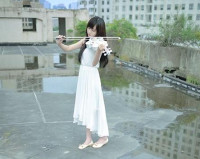2001-Views-Animation-3D-Transition
来源:互联网 发布:结构优化是什么意思 编辑:程序博客网 时间:2024/06/04 19:58
介绍一个3D动画的旋转动画
package com.example.android.apis.animation;import com.example.android.apis.R;import android.app.Activity;import android.os.Bundle;import android.widget.ListView;import android.widget.ArrayAdapter;import android.widget.AdapterView;import android.widget.ImageView;import android.view.View;import android.view.ViewGroup;import android.view.animation.Animation;import android.view.animation.AccelerateInterpolator;import android.view.animation.DecelerateInterpolator;/** * This sample application shows how to use layout animation and various * transformations on views. The result is a 3D transition between a * ListView and an ImageView. When the user clicks the list, it flips to * show the picture. When the user clicks the picture, it flips to show the * list. The animation is made of two smaller animations: the first half * rotates the list by 90 degrees on the Y axis and the second half rotates * the picture by 90 degrees on the Y axis. When the first half finishes, the * list is made invisible and the picture is set visible. */public class Transition3d extends Activity implements AdapterView.OnItemClickListener, View.OnClickListener { private ListView mPhotosList; private ViewGroup mContainer; private ImageView mImageView; // Names of the photos we show in the list private static final String[] PHOTOS_NAMES = new String[] { "Lyon", "Livermore", "Tahoe Pier", "Lake Tahoe", "Grand Canyon", "Bodie", "Lyon", "Livermore", "Tahoe Pier", "Lake Tahoe", "Grand Canyon", "Bodie" }; // Resource identifiers for the photos we want to display private static final int[] PHOTOS_RESOURCES = new int[] { R.drawable.photo1, R.drawable.photo2, R.drawable.photo3, R.drawable.photo4, R.drawable.photo5, R.drawable.photo6, R.drawable.photo1, R.drawable.photo2, R.drawable.photo3, R.drawable.photo4, R.drawable.photo5, R.drawable.photo6 }; @Override protected void onCreate(Bundle savedInstanceState) { super.onCreate(savedInstanceState); setContentView(R.layout.animations_main_screen); mPhotosList = (ListView) findViewById(android.R.id.list); mImageView = (ImageView) findViewById(R.id.picture); mContainer = (ViewGroup) findViewById(R.id.container); // Prepare the ListView final ArrayAdapter<String> adapter = new ArrayAdapter<String>(this, android.R.layout.simple_list_item_1, PHOTOS_NAMES); mPhotosList.setAdapter(adapter); mPhotosList.setOnItemClickListener(this); // Prepare the ImageView mImageView.setClickable(true); mImageView.setFocusable(true); mImageView.setOnClickListener(this); // Since we are caching large views, we want to keep their cache // between each animation mContainer.setPersistentDrawingCache(ViewGroup.PERSISTENT_ANIMATION_CACHE); } /** * Setup a new 3D rotation on the container view. * * @param position the item that was clicked to show a picture, or -1 to show the list * @param start the start angle at which the rotation must begin * @param end the end angle of the rotation */ private void applyRotation(int position, float start, float end) { // Find the center of the container final float centerX = mContainer.getWidth() / 2.0f; final float centerY = mContainer.getHeight() / 2.0f; // Create a new 3D rotation with the supplied parameter // The animation listener is used to trigger the next animation final Rotate3dAnimation rotation = new Rotate3dAnimation(start, end, centerX, centerY, 310.0f, true); rotation.setDuration(500); rotation.setFillAfter(true); //AccelerateInterpolator:动画从开始到结束,变化率是一个加速的过程。 //DecelerateInterpolator:动画从开始到结束,变化率是一个减速的过程。 //CycleInterpolator:动画从开始到结束,变化率是循环给定次数的正弦曲线。 //AccelerateDecelerateInterpolator:动画从开始到结束,变化率是先加速后减速的过程。 rotation.setInterpolator(new AccelerateInterpolator()); rotation.setAnimationListener(new DisplayNextView(position)); mContainer.startAnimation(rotation); } public void onItemClick(AdapterView parent, View v, int position, long id) { // Pre-load the image then start the animation mImageView.setImageResource(PHOTOS_RESOURCES[position]); applyRotation(position, 0, 90); } public void onClick(View v) { applyRotation(-1, 180, 90); } /** * This class listens for the end of the first half of the animation. * It then posts a new action that effectively swaps the views when the container * is rotated 90 degrees and thus invisible. */ private final class DisplayNextView implements Animation.AnimationListener { private final int mPosition; private DisplayNextView(int position) { mPosition = position; } public void onAnimationStart(Animation animation) { } public void onAnimationEnd(Animation animation) { mContainer.post(new SwapViews(mPosition)); } public void onAnimationRepeat(Animation animation) { } } /** * This class is responsible for swapping the views and start the second * half of the animation. */ private final class SwapViews implements Runnable { private final int mPosition; public SwapViews(int position) { mPosition = position; } public void run() { final float centerX = mContainer.getWidth() / 2.0f; final float centerY = mContainer.getHeight() / 2.0f; Rotate3dAnimation rotation; if (mPosition > -1) { mPhotosList.setVisibility(View.GONE); mImageView.setVisibility(View.VISIBLE); mImageView.requestFocus(); rotation = new Rotate3dAnimation(90, 180, centerX, centerY, 310.0f, false); } else { mImageView.setVisibility(View.GONE); mPhotosList.setVisibility(View.VISIBLE); mPhotosList.requestFocus(); rotation = new Rotate3dAnimation(90, 0, centerX, centerY, 310.0f, false); } rotation.setDuration(500); rotation.setFillAfter(true); rotation.setInterpolator(new DecelerateInterpolator()); mContainer.startAnimation(rotation); } }}Rotate3dAnimation.java/* * Copyright (C) 2007 The Android Open Source Project * * Licensed under the Apache License, Version 2.0 (the "License"); * you may not use this file except in compliance with the License. * You may obtain a copy of the License at * * http://www.apache.org/licenses/LICENSE-2.0 * * Unless required by applicable law or agreed to in writing, software * distributed under the License is distributed on an "AS IS" BASIS, * WITHOUT WARRANTIES OR CONDITIONS OF ANY KIND, either express or implied. * See the License for the specific language governing permissions and * limitations under the License. */package com.example.android.apis.animation;import android.view.animation.Animation;import android.view.animation.Transformation;import android.graphics.Camera;import android.graphics.Matrix;/** * An animation that rotates the view on the Y axis between two specified angles. * This animation also adds a translation on the Z axis (depth) to improve the effect. */public class Rotate3dAnimation extends Animation { private final float mFromDegrees; private final float mToDegrees; private final float mCenterX; private final float mCenterY; private final float mDepthZ; private final boolean mReverse; private Camera mCamera; /** * Creates a new 3D rotation on the Y axis. The rotation is defined by its * start angle and its end angle. Both angles are in degrees. The rotation * is performed around a center point on the 2D space, definied by a pair * of X and Y coordinates, called centerX and centerY. When the animation * starts, a translation on the Z axis (depth) is performed. The length * of the translation can be specified, as well as whether the translation * should be reversed in time. * * @param fromDegrees the start angle of the 3D rotation * @param toDegrees the end angle of the 3D rotation * @param centerX the X center of the 3D rotation * @param centerY the Y center of the 3D rotation * @param reverse true if the translation should be reversed, false otherwise */ public Rotate3dAnimation(float fromDegrees, float toDegrees, float centerX, float centerY, float depthZ, boolean reverse) { mFromDegrees = fromDegrees; mToDegrees = toDegrees; mCenterX = centerX; mCenterY = centerY; mDepthZ = depthZ; mReverse = reverse; } @Override public void initialize(int width, int height, int parentWidth, int parentHeight) { super.initialize(width, height, parentWidth, parentHeight); mCamera = new Camera(); } @Override protected void applyTransformation(float interpolatedTime, Transformation t) { final float fromDegrees = mFromDegrees; float degrees = fromDegrees + ((mToDegrees - fromDegrees) * interpolatedTime); final float centerX = mCenterX; final float centerY = mCenterY; final Camera camera = mCamera; final Matrix matrix = t.getMatrix(); camera.save(); if (mReverse) { camera.translate(0.0f, 0.0f, mDepthZ * interpolatedTime); } else { camera.translate(0.0f, 0.0f, mDepthZ * (1.0f - interpolatedTime)); } camera.rotateY(degrees); camera.getMatrix(matrix); camera.restore(); matrix.preTranslate(-centerX, -centerY); matrix.postTranslate(centerX, centerY); }} 0 0
- 2001-Views-Animation-3D-Transition
- Android ApiDemos示例解析(95):Views->Animation->3D Transition
- APIDemos例子3D Transition学习(自定义Animation)
- Android Api Demos登顶之路(九十八)Text-->Animation->3D Transition
- APIDemo学习笔记——Android上几种简单的Animation使用方法(三)——3D Transition
- CSS3 transition与animation
- Android Animation之transition
- Android Animation之transition
- CSS3 Transform & Transition & Animation
- transition, transform和animation
- Transform / Transition / Animation 区别
- animation和transition
- CSS3_Node3_transform&transition&animation
- transition\animation动画
- transition -- animation -- transform
- transition,transform,animation
- Transition animation使用笔记
- CSS3之animation、transition
- 第12周-项目3-摩托车继承自行车和机动车
- 异常:基础连接已经关闭: 未能为 SSL/TLS 安全通道建立信任关系。
- ie 盒子模型和标准 w3c 盒子模型
- python基础教程_学习笔记3:列表
- table网格线
- 2001-Views-Animation-3D-Transition
- linux awk命令详解
- FZU 1969数论 GCD+欧拉函数应用
- oracle优化
- 学会提问
- 【算法思想】过河问题(续)
- java 实现播放声音
- wcf 本地套接字超时错误的解决办法
- UVA 10635 - Prince and Princess (LCS转成LIS DP)


